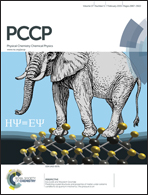A QM/MM study of Kemptide phosphorylation catalyzed by protein kinase A. The role of Asp166 as a general acid/base catalyst
Abstract
In this work a theoretical study of the γ-phosphoryl group transfer from ATP to Ser17 of the synthetic substrate Kemptide (LRRASLG) in protein kinase A (PKA) has been carried out with a solvated model of the PKA–Mg2ATP–Kemptide system based on the 1CDK X-ray crystallographic structure. We have used high levels (B3LYP/MM and MP2/MM) of theory to determine the overall reaction paths of the so-called concerted loose mechanism trying to clarify some aspects of that mechanism still under debate. Our calculations demonstrate for the first time in a complete model of the ternary system the viability of the final step of the catalytic mechanism in which the protonation of the phosphokemptide product by Asp166 takes place. Asp166 is a base catalyst that abstracts the HγSer17 of Kemptide thus facilitating the phosphoryl transfer, but it also acts as an acid catalyst by donating the proton just accepted from Ser17 to the O2γATP atom of the phosphoryl group.


 Please wait while we load your content...
Please wait while we load your content...